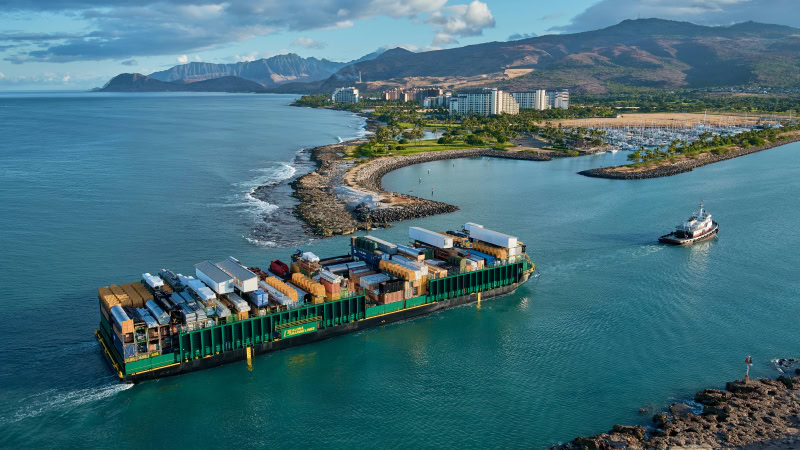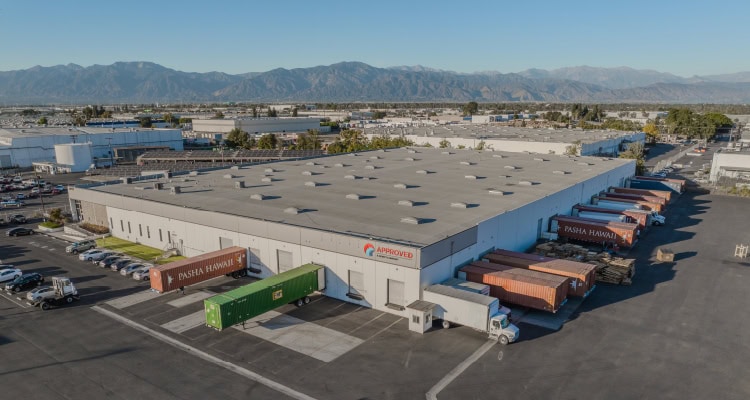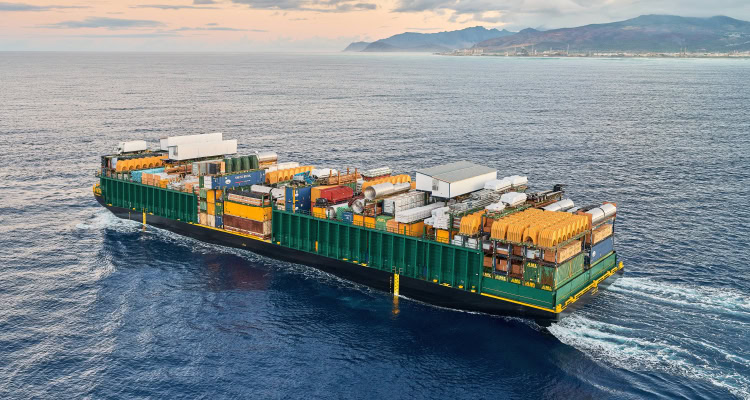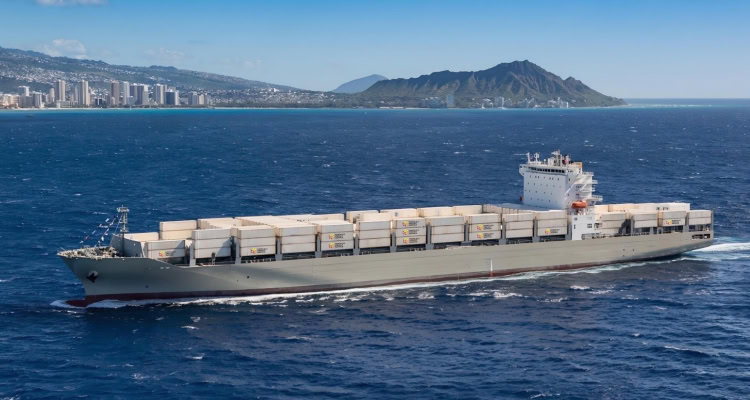Hawaii Logistics: Maintaining the Island Flow

Keeping cargo movement flowing to and from Hawaii’s multiple locations requires logistics savvy, specialized experience, and inter-island ingenuity. Call it Aloha spirit or pure persistence; these providers go the distance for every shipment.
Some 59,000 people move to Hawaii each year, and some 10 million visit. Why so many? Why not? The state’s “Aloha spirit,” characterized by the sunny disposition of a tropical paradise, invites tourists and year-round residents alike.
Although Hawaii is one of the most remote island chains in the world, the state’s nearly 1.5 million citizens are not so remote from the circumstances of everyday American life that they do not want and need the same staples that everyone who lives on the mainland does.
Fortunately for those who live and work in Hawaii—including those working in its approximately 135,000 businesses—leading logistics providers navigate the delivery of goods to and from the islands with a level of efficiency that complements the state’s comfortable ambiance.
While this necessitates handling shipping challenges that in some ways are more difficult than those in the other states, technological advances and fleet improvements combine to give logistics professionals the tools they need to make it all work.
Enhancing their efforts is a transportation infrastructure that includes a substantial network of airports, ports, and highways to help facilitate logistics operations and fuel economic growth. The network includes five international airports, nearly 2,500 miles of roads and highways, and 10 commercial harbors. The state relies heavily on maritime transport for both inter-island and international shipments, with Honolulu Harbor being the largest in terms of tonnage.
By Air or By Sea: Infrastructure Upgrades Abound
Hawaii’s primary airports are Daniel K. Inouye International Airport (Oahu); Kahului Airport (Maui); Lihue Airport (Kauai); Hilo International Airport on the east side of the Island of Hawaii; and Ellison Onizuka Kona International Airport, the primary airport on the Island of Hawaii, located in West Hawaii at Keahole.
An airport modernization program established by Gov. Josh Green is designed to enhance Hawaii’s visitor and traveler experience as well as transform the state’s airports into distinctive, functional, world-class facilities.
The goals of the modernization program, developed in close cooperation with airlines and other visitor-industry partners, include expanding capacity, improving safety and efficiency, creating jobs, and integrating sustainability principles.
In 2025, the Hawaii Department of Transportation (HDOT) announced that the state’s airports system raised $849 million in bond financing to fund approximately $600 million of essential projects to upgrade and expand airport infrastructure, including runway repairs, terminal renovations, security enhancements, and construction of new facilities. The funding program also provides for refinancing $233 million of existing debt, generating more than $23 million in interest cost savings. The transaction represents the largest bond issuance for the airports system in its history.
Meanwhile, Hawaii’s ports build on their long history as vital links in the supply chain. Maritime commerce grew rapidly following Hawaii’s establishment as a U.S. state in 1959. Harbor construction, dredging, and landfilling activities continued in order to accommodate increasing demands for goods and other essential materials.
The statewide harbor system consists of harbors at Honolulu, Kalaeloa Barbers Point, Hilo, Kawaihae, Kahului, Hana, Kaunakakai, Kaumalapau, Nawiliwili, and Port Allen. Honolulu Harbor functions as the port hub of Hawaii by receiving, consolidating, and distributing practically all overseas cargo shipments, as well as catering to passenger and fishing operations. These maritime operations provide the majority of basic necessities, including food, clothing, construction materials, fuel, and other essential supplies.
Today, efforts continue to maintain, develop, and plan for essential harbor infrastructure that supports maritime operations. HDOT’s Honolulu Harbor Master Plan Update is part of an ongoing strategic plan for the infrastructural development, terms of use, and optimization of the port and its facilities to best serve future cargo handling, storage, and distribution requirements, as well as non-cargo maritime operations and maritime support services.
Highway Highlights
Further strengthening Hawaii’s logistics infrastructure are the paved freeways, highways, and roadways that criss-cross the state’s six major islands. This includes four interstate highways located on Oahu.
Among highway improvements currently planned or in progress, of particular interest to logistics providers is the widening and construction of new retaining walls on the H-1 Freeway, Hawaii’s longest and busiest interstate highway. The highway runs east-west on Oahu, connecting Kapolei to Kahala. Crucial to its importance for logistics, H-1 links downtown Honolulu with Honolulu International Airport, military installations, and suburban areas.
Keeping abreast of Hawaii’s shipping enhancements on land, in the air, and at sea are logistics providers who specialize in navigating Hawaii’s unique infrastructure, understanding both its advantages and challenges.
Approved Freight Forwarders: Better and Better

Approved Freight Forwarders started more than 30 years ago serving the Guam market and has expanded to Hawaii and California, serving as a key link to the Pacific and around the world.
From the perspective of Approved Freight Forwarders, the logistics assets of Hawaii are steadily improving. “Over the past several years, we’ve seen continued investment in port infrastructure, improvements in shipping technology, and stronger integration with mainland supply chains,” says Eric Zybura, the company’s CEO and president.
“These advancements could lead to increased reliability and shortened transit times—both crucial for Hawaii’s unique supply chain ecosystem. Additionally, digital tools and enhanced tracking systems have brought better visibility to cargo movement, helping shippers make smarter, faster decisions.”
Approved Freight Forwarders, part of the DeWitt Family of Businesses, got its start more than three decades ago serving the Guam market and has since expanded to Hawaii and California, serving as a key link to the Pacific and all around the world. “One key factor in our success in solving our customers’ unique challenges is the relationship we have with our sister company, Royal Hawaiian Movers, the largest mover located in Hawaii,” Zybura says.
“Their skilled delivery and installation services give us an added layer of custom logistics solutions to offer our customers,” he adds. “We rely on them and their significant labor pool to offer unique and specialized white-glove delivery, installation, and other services.”
Approved Freight has mirrored the logistics improvements of the state itself. “As a company deeply rooted in Hawaii since 2006, we’ve built one of the most comprehensive freight networks in the islands,” says Zybura. “With terminals on Oahu, Maui, the Big Island, and Kauai, we offer true end-to-end service that few can match. We’ve made substantial investments in technology, including near real-time shipment tracking and digitized documentation processes that simplify the freight experience for customers.”
Deploying A Specialized, Localized Approach
Approved Freight also has optimized its inland-to-Hawaii consolidation services and invested in scalable infrastructure, including state-of-the-art warehouses in Honolulu and Los Angeles, to support faster throughput and better inventory management.
Hawaii’s geography is both its strength and its biggest challenge, Zybura notes. He cites port congestion, unpredictable weather, limited warehousing space, and inter-island logistics as among the major challenges.
“People may assume that Hawaii’s logistics are simply an extension of West Coast shipping,” Zybura says. “The reality is that Hawaii requires a specialized, localized approach; it almost requires a mixed international and local solution. Inter-island freight operations, local delivery nuances, and port-specific regulations create a logistics environment that’s quite distinct from mainland models.
“Another misconception is that service levels are lower or slower in Hawaii,” he adds. “In truth, providers like Approved Freight Forwarders have built highly responsive, customer-focused operations that rival—and often exceed—mainland standards.
“If you are able to get the logistics plan right, you can create a differentiated strategy to outpace competitors,” Zybura says. “At Approved Freight Forwarders we pride ourselves in creating customized logistics solutions to help our customers create those differentiated strategies.”
Zybura is optimistic about Hawaii’s continued importance in worldwide logistics. “Hawaii remains a vital link in the Pacific and a key market for mainland shippers,” he says. “As global trade patterns shift and ecommerce expands, Hawaii’s role as a strategic hub is only growing. Investments in technology and infrastructure—combined with the resilience of our local logistics community—position us well for the future.”
Lynden: Synergies of Service

The Lynden family of companies, including Aloha Marine Lines (AML), provides transportation and logistics solutions in Hawaii, Alaska, Canada, the Pacific Northwest, and around the world.
As the saying goes, “The whole is greater than the sum of its parts.” A strong case in point is Aloha Marine Lines (AML), a barge service company that is part of the powerful Lynden family of companies providing transportation and logistics solutions in Hawaii, Alaska, Canada, the Pacific Northwest, and around the world.
“In addition to barge service, we can provide air and ocean forwarding services to Hawaii, and trucking services throughout the mainland,” says Bret Harper, Aloha Marine Lines’ vice president of sales. “Our combined capabilities allow customers to have their freight picked up from suppliers on the mainland and shipped to Hawaii all by the same company, simplifying the entire process.
“If something needs to be delivered quickly, we can transport it via air or ship,” he adds. “If it’s less urgent, we can save the customer money by using our barge service. We call this service Dynamic Routing.”
The companies’ synergies add up to an approach that leverages their combined resources and expertise to ensure a seamless and coordinated delivery of goods, often across multiple modes of transportation on air, land, and sea. “We work together and can utilize all our services,” Harper explains.
The unique challenges of providing logistics services to and from Hawaii include navigating 2,400 miles across the Pacific Ocean, Harper notes, and then traversing the distances within and among the islands.
AML’s fleet of barges and specialized container equipment enables the company to overcome these challenges for both small and large shipments with efficiency and speed.
AML’s Makani Class barges, for example, measure 438 feet long and 105 feet wide, with a deadweight capacity of 16,900 tons. They are fitted with high binwalls, which help to keep freight secure while minimizing the amount of lashing needed for each voyage.
Lynden Logistics, also part of the Lynden family of companies, provides global freight forwarding. “You can have one point of contact anywhere in the world by tapping into Lynden Logistics,” Harper says. Lynden Logistics provides air and ocean freight forwarding, expedited ground freight services, customs brokerage, and other specialized services such as charters, barcode scanning and assembly, and distribution.
Providing Turn-Key Solutions
The assets and experience of AML and its partners enable the company to meet the challenges of the state’s unique and complex infrastructure. Recently, they have been called upon to assist in emergencies such as the Hawaii wildfires.
In late 2024, AML delivered the third barge load of modular units to Maui for a FEMA project supporting the Lahaina fire rebuild efforts. “We were glad we could assist in a small way with the ongoing Maui recovery efforts,” says Harper. “These barges were loaded with temporary housing units for displaced residents. We worked within tight deadlines and load requirements to move 83 modulars on trailers from Seattle directly to Kahului, Maui.”
Meanwhile, AML and Lynden Logistics are supporting the Navy’s Shipyard Optimization Program (SIOP) to replace Dry Dock 3 at Pearl Harbor. The project is a key investment for the Navy to increase capacity and modernize shipyards through upgraded dry docks, facilities, and new equipment.
“We view ourselves as logistics consultants,” Harper says. “We provide turn-key solutions that make the shipping process easy for customers.”
Honolulu Freight Service: Constancy of Change

Serving the Pacific for nearly 90 years, Honolulu Freight Service (HFS) moves shipments in a timely manner, providing visibility and shipment information over sea, land, and air.
Change is a constant in logistics, and Hawaii is no exception. The most successful logistics providers ensure their clients experience seamless delivery, especially as conditions evolve. Growth and innovation are strategies Honolulu Freight Service (HFS) has managed well as the freight forwarder serving the Pacific for nearly 90 years.
Its success has been displayed by building a tradition of superior service and cost-effective solutions for every customer. Through its growing network of asset-based trucking companies, state-of-the-art terminals, warehouses, logistics technologies, and detailed tracking information, HFS can provide visibility and shipment information over land, air, and sea.
2025 marks a major shift in operations for HFS through infrastructure and technology improvements to its Hawaii services. After years of growth, HFS is completing renovations for its new Hawaii headquarters at the former Love’s Bakery headquarters in the heart of Honolulu.
This 92,400-square-foot building and three acres of industrial property will allow the company to streamline and upgrade operations.
“The new location provides operational efficiencies and expands in-town chilled and frozen as well as dry storage potential,” says James Beidleman, HFS president and CEO. “Eventually, two of the three HFS operations will be consolidated into this new headquarters.” The new location is slated to open in late 2025 with more than 200 employees.
Through their new operating system, HFS is replacing several manual processes with new software and technology throughout each division.
“This puts the focus on the customer rather than on administrative personnel. New procedures are being adopted to include e-signatures, dispatch systems, communications, and other tools,” Beidleman says, adding that HFS is also evaluating new technologies for more efficient real-time temperature controls throughout shipment and cold chain handling.
“Our goal is to keep shipments moving in a timely manner throughout the islands, and that is particularly critical for refrigerated goods,” he says. “We’ve developed an unbroken cold chain for all shipments—big and small—throughout the islands that is rolling out this year, so goods never sit on an open tarmac in the sun.”
Due to Hawaii’s location, logistics providers need to be familiar with ocean/consolidation/rail/truck and final-mile delivery all in one shop. “Our ability to provide all of this is what makes Honolulu Freight Service stand out,” Beidleman says.
Maintaining Complete Cold Chain Control
HFS has introduced a new local less-than-container load (LCL) system for its inter-island chilled and frozen shipments to greatly improve control and consistency in the cold chain, Beidleman adds. Chilled and frozen goods are loaded directly into dedicated refrigerated shipping containers by pallet, then shipped inter-island, with shipments once a week.
HFS trucks can immediately deliver door-to-door to the customer with complete control over the cold chain. Unloading onto the terminal floor or wait times outside in the open environment, are things of the past.
“This system greatly helps local neighbor-island businesses with LCL shipments of sensitive materials, such as perishable food items,” Beidleman says. HFS loads direct containers between Oahu, Maui, Kauai, and the Island of Hawaii once a week.
Complementing the HFS inter-island cold chain container movements are their daily inter-island airfreight movements. This service is a function of their Oahu-based trucking division (XPress Trucking). Inter-island airfreight moves through their TSA-approved facilities, providing same-day transportation of products between each of the Hawaiian Islands.
2026 will mark 90 years of service for the company under the third generation of Beidleman family ownership and management. “Working together with the hundreds of families at HFS, we are so proud and thankful for what we’ve built, and we are excited about what lies ahead,” Beidleman notes.
In addition to Honolulu, HFS terminal locations include Tacoma, Washington; Los Angeles and Oakland, California; Portland, Oregon; and Guam.
Seamless Shipping
The Aloha spirit that typifies Hawaii is a term that is especially apt in the islands’ world of logistics. “Aloha” is a word used in both greeting and farewell. For logistics providers, Aloha spirit typifies how cargo shipments are handled both entering and leaving the state.
“Mahalo” is another word spoken both in greeting and farewell on the islands. It is an expression of gratitude and thanks. Not surprisingly, logistics pros serving the state hear it often.
